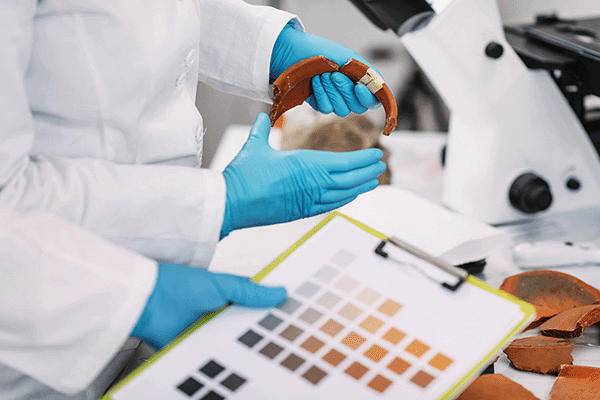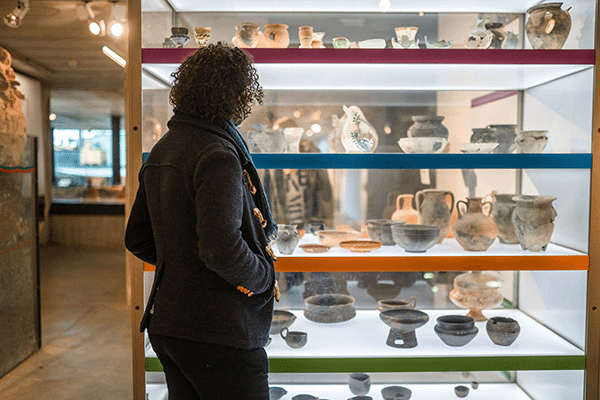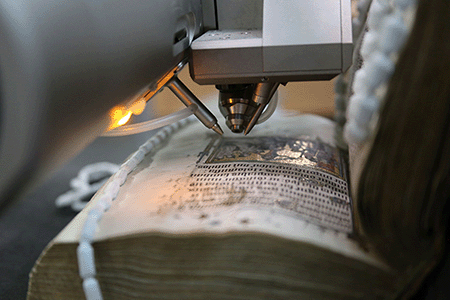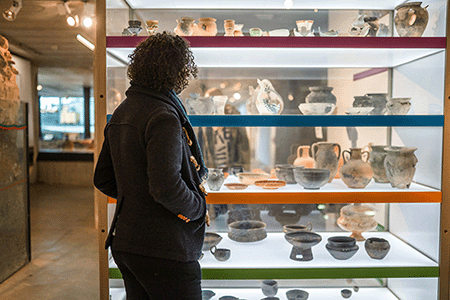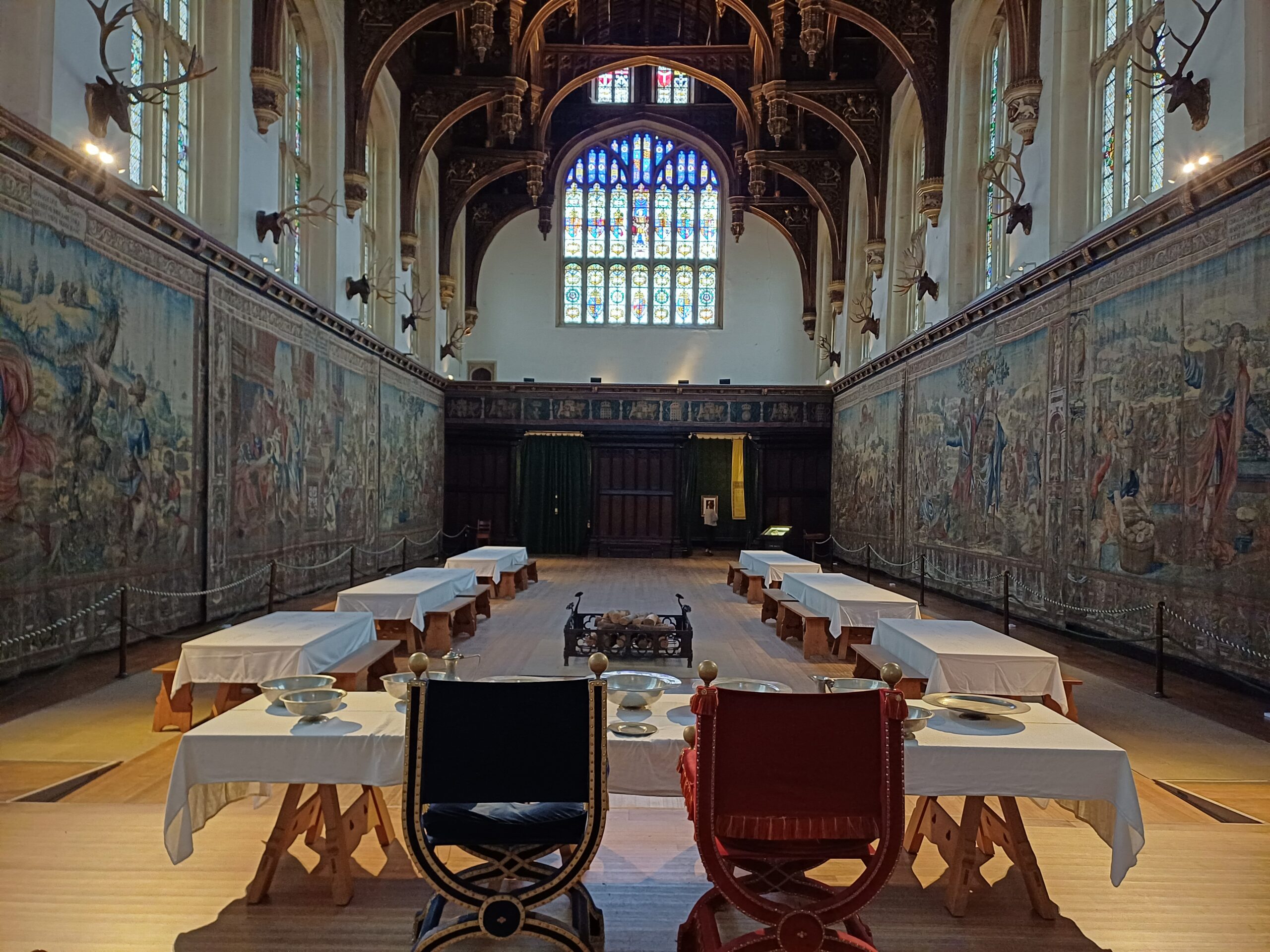The RICHeS Team had the privilege of visiting Hampton Court Palace a site managed by Historic Royal Palaces (HRP), where the team met with Dr Constantina Vlachou-Mogire, the Heritage Science Manager and Project Lead of the Tranche 1 Collections RICHeS Funded project. Our visit provided an opportunity to delve into their innovative project and gain insights into the cutting-edge research being conducted on site.
The Heritage Science Team is based at Hampton Court Palace and provides technical support and advice across all HRP’s six sites including the Tower of London. The laboratory was founded 35 years ago and since then has established a distinguished reputation in the field of heritage science and conservation research. The substantial investment of nearly £1m from the Arts and Humanities Research Council Capability for Collections Fund (CapCo), provided a rare opportunity to renew dated equipment and expand HRP’s research infrastructure with a state-of-the-art equipment for the documentation and analysis of heritage assets.
HRPs conservation and scientific research efforts are central to the preservation of its historical assets including, but not limited to, the notable tapestries in the Great Hall and the Great Watching Chamber. These tapestries, part of the Royal Collection, offer a vivid look into the Tudor period, showcasing impressive craftsmanship and historical ambiance. Through cutting-edge research, the palace effectively balances heritage conservation and preservation with visitor engagement, ensuring that these collections are maintained for future generations.
The Great Hall and its tapestries
At the heart of Hampton Court is the Great Hall, England’s largest surviving medieval hall. Commissioned by Henry VIII, its architecture draws visitors into the world of the Tudor court. Its majestic oak-beamed ceiling and intricately carved wooden details serve as reminders of the Tudor period while the sunlight pierces through its stained-glass windows, bathing the hall in beautiful warm hues. The same light casts a glow on the majestic and historic tapestries that line the walls. These tapestries, including the renowned Story of Abraham series, are masterpieces of Renaissance textile art, celebrated for their impressive size, vibrant colours and detailed storytelling.

The science of preserving history
The palace’s historic tapestries are both awe-inspiring artefacts and delicate textiles, vulnerable to light, temperature and humidity. The Conservation and Collection Care, and Collections Management team uses a variety of scientific techniques to care for these pieces. Innovative material analysis using the CapCo purchased hyperspectral imaging scanner reveals the chemical signature of the fibres and dyes used in these tapestries, allowing conservators to understand the original composition and identify the best preservation methods. Techniques like spectrophotometry, a method to measure how much a substance absorbs light, are used to monitor colour fading, while digital microscopy provides insights into the health of fibres, guiding careful cleaning and restoration.
A vision for the future: The REVEAL project
HRP’s strong commitment to conservation is supported by its latest initiative, the Historic Royal Palaces REsearch Vault for HEritAge science coLlections (REVEAL) project, funded by RICHeS. This project aims to create a state-of-the-art physical and digital repository for scientific samples and research data. For the physical archives, new storage facilities for the vast array of samples collected not only from Hampton Court Palace but across all HRP sites will be created. These reference collections include textile samples ranging from individual threads to large fragments, furnishings and costumes, paint samples of historic buildings and decorative schemes from renowned artists such as Sir Peter Paul Rubens, Sir James Thornhill and William Kent. The collections will also include a unique archive of historic building materials, covering over 1,000 years of architectural history. Complementing this, a substantial digital repository will catalogue and preserve analytical data, technical studies and findings from ongoing and past research projects. Notable assets will include 3D laser scanning data, digital twins of artefacts and spaces, as well as analytical and environmental monitoring data that enable an increased understanding of these significant historic sites and their collections. The team will work closely with project partners from other heritage organisations, academia, industry and professional practitioners to ensure that their input informs the design and delivery of this research facility.
By improving and safeguarding this wealth of information, the REVEAL project ensures that the palace’s conservation and research efforts can continue to evolve. It will also provide researchers, conservators and historians with unparalleled access to sample collections and data, supporting future innovations in heritage science.

RICHeS and REVEAL advancing heritage science
RICHeS visit to Hampton Court Palace was a compelling demonstration of how heritage science and conservation work hand-in-hand to preserve history while embracing innovation. This visit highlighted the transformative role of RICHeS funding in advancing heritage science. By strategically investing in cutting-edge projects like REVEAL, RICHeS not only safeguards invaluable collections but also empowers researchers and conservators to harness emerging technologies, driving new discoveries and fostering a deeper connection to our shared heritage.
Dr Constantina Vlachou-Mogire shares…
“We were delighted to welcome the RICHeS Team at Hampton Court Palace and the HRP Heritage Science Laboratory to discuss how scientific research underpins the conservation of our palaces and collections. We are thrilled to be part of the RICHeS programme and we look forward to working with the RICHeS team and our external partners on the successful delivery of the REVEAL repository an important resource to facilitate research not only by academic, heritage organisations and industry but also students, artists and community groups“

